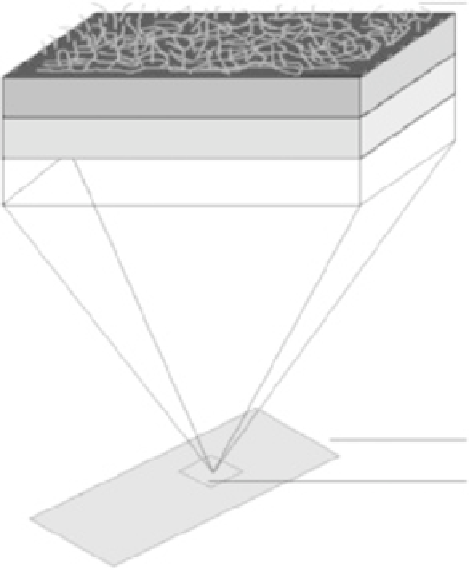Agriculture Reference
In-Depth Information
Dextran surface matrix
Linker layer
Gold layer
Glass support
Biacore sensor chip
Gold area on chip
A typical Biacore chip with the binding surface enlarged.
Fig. 20.3
which results in a high response that is advantageous for capture assays, especially for
those involving the interactions of small molecules (see later). The high-surface stabil-
ity permits accuracy and precision, and repeated analysis on the same surface may be
performed (Dillon et al., 2005).
The streptavidin (SA) chip has a carboxymethylated dextran matrix preimmobilized with
streptavidin for the immobilization of biotinylated peptides, proteins, nucleic acids, and
carbohydrates.
The nitrilotriacetic acid (NTA) chip consists of a matrix of carboxymethylated dextran
preimmobilized with Ni
2
+
(nickel)-NTA. It is used to immobilize naturally and recom-
binant histidine-tagged molecules.
Another chip (C1 four-channel sensor chip) was selected for use by Schlecht et al.
(2002) to measure two herbicides: 2,4-dichlorophenoxyacetic acid (2,4-D) and 2,4,5-
trichlorophenoxyacetic acid (2,4,5-T). This was performed by immobilizing haptens di-
rectly on the surface of the chip using a thiol immobilization method.
For analytes with a low molecular weight, it is often necessary to employ an indirect
measurement method where the analyte is immobilized directly on a biosensor chip. If
the analyte is immunogenic (an antibody can be raised against it), then it is possible to
use a competitive or inhibition immunoassay to measure it (Fig. 20.4). An inhibition assay
involves the combination of the sample of interest with the specific antibody before injection
onto a biosensor chip containing an immobilized target molecule. There is competition










Search WWH ::

Custom Search